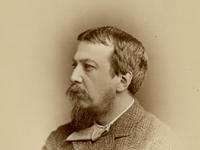Answer: Silas Weir Mitchell
Philadelphia was the home of Silas Weir Mitchell, a 19th-century physician and author who specialized in nervous disorders and hysteria. Mitchell, the son of noted physician John Kearsley Mitchell, attended the University of Pennsylvania and Jefferson Medical College. His career took off after the Civil War, as he delved further into the field of neurology. He was the first to describe erythromelalgia, which was then called “Mitchell’s Disease,” a disorder that attacks a patient’s extremities (hands, arms, and feet) and causes burning and swelling. He also became one of the first doctors to study the nervous condition called “hysteria” in women.
To treat nervous disorders, Mitchell often prescribed his “rest cure.” This cure—which involved bed rest, isolation, dieting, and massage—became widely used in the United States and Europe, though it was not without its critics. In 1892, author and activist Charlotte Perkins Gilman wrote a semi-autobiographical short story called The Yellow Wallpaper in which the main character, a woman, went mad after being prescribed the “rest cure.”
Mitchell was also a poet and author. His most famous novel was Hugh Wynne, Free Quaker (1898), a story of historical fiction that was set in Philadelphia during the Revolutionary War. He lived his whole life in Philadelphia and died at his home in 1914. He was buried in Woodlands Cemetery.
The society has several of Silas Weir Mitchell's books in the library, from his medial works to his fiction. Additionally, among our manuscript collections are Silas Weir Mitchell autobiography (Am. 10477) and Hugh Wynne: Free Quaker (extra illustrated biography) by Silas Weir Mitchell (Ar .99 M68).
Image: Silas Weir Mitchell, photograph by F. Gutekunst (1876)

